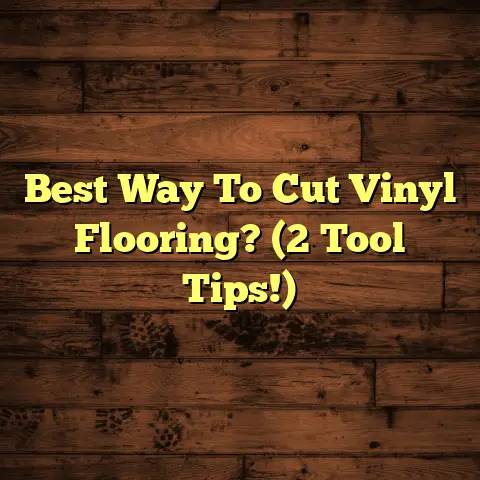Staples in Hardwood: Quick Removal? (3 Pro Tips!)
Did you know that a well-maintained hardwood floor can last over a century?
It’s true! But here’s the kicker: improper installation or even a careless renovation can introduce nightmares like forgotten staples.
Trust me, I’ve seen it all in my years as a flooring contractor. Let’s dive into how to tackle those pesky staples!
Section 1: Understanding the Problem
with Staples in Hardwood
So, what’s the deal with staples in hardwood floors, anyway?
Well, staples are those small, U-shaped metal fasteners.
They’re often used during the installation process to secure underlayment or even the hardwood planks themselves.
Think of them as temporary helpers, meant to hold things in place until the adhesive sets or the nails are driven.
But here’s where things get tricky.
Sometimes, during a DIY project gone wrong, or when replacing old flooring, these staples get left behind.
Maybe they’re broken, bent, or just plain forgotten. I’ve seen it happen!
And what’s the big deal if they’re left behind?
Well, for starters, they can cause some serious damage. Imagine walking across your beautiful hardwood floor and snagging your sock on a rusty staple.
Ouch!
More seriously, they can scratch, dent, or even puncture the wood.
Over time, moisture can get in, leading to rot and decay. Not good!
Plus, if you’re planning to refinish your floors, those staples will wreak havoc on your sanding equipment.
Trust me, replacing a sander drum is way more expensive than removing a few staples!
Section 2: Pro Tip 1 – Assess the Situation
Alright, so you suspect you have staples lurking in your hardwood.
What’s the first step?
Assess the situation.
Grab a good flashlight – I prefer the kind with an adjustable beam – and maybe even a magnifying glass.
Get down on your hands and knees (yes, your knees will thank you later if you use pads) and really examine the floor.
What are you looking for?
First, the obvious: visible staples.
But also look for small holes or indentations that might indicate a staple that’s broken off or been partially removed.
Pay close attention to areas where you know work has been done, like along walls or near doorways.
Now, not all staples are created equal.
Some will be sticking up proudly, begging to be removed. Others will be flush with the surface, almost invisible to the naked eye.
And some will be rusted, bent, or otherwise compromised.
The key here is to determine which staples are easily removable and which might require a more delicate approach.
A staple that’s sticking up and relatively straight?
Easy peasy. A rusted, bent staple that’s buried deep in the wood?
That’s going to be a bit more challenging.
I usually mark the location of each staple with a piece of painter’s tape. That way, I don’t lose track of them while I’m gathering my tools.
Section 3: Pro Tip 2 – Choosing the
Right Removal Tools
Okay, you’ve assessed the situation and know what you’re up against.
Now it’s time to arm yourself with the right tools.
Here are my go-to staples removal tools:
-
Staple Puller: This is a specialized tool designed specifically for removing staples. It has a forked end that slides under the staple and a handle that provides leverage to pull it out. I like the kind with a rubber grip for added comfort. You can find these at most hardware stores or online.
-
Pliers: A good pair of needle-nose pliers or lineman’s pliers can be invaluable for gripping and pulling staples. Look for pliers with comfortable handles and a strong grip.
-
Flathead Screwdriver: A small, flathead screwdriver can be used to gently pry up staples that are flush with the surface. Be careful not to damage the surrounding wood!
-
Pry Bar: For those really stubborn staples, a small pry bar can provide the extra leverage you need. Again, be careful not to damage the floor.
-
Hammer: Sometimes, a gentle tap with a hammer can help loosen a stubborn staple. Use a rubber mallet to avoid damaging the wood.
-
Wood Chisel: In extreme cases, you might need to use a wood chisel to carefully chip away the wood around a staple. This should be a last resort, as it can easily damage the floor.
-
Safety Glasses: Always, always wear safety glasses when working with tools. You don’t want a flying staple to end up in your eye.
-
Gloves: Protect your hands from splinters and sharp edges by wearing a good pair of work gloves.
When choosing your tools, consider the type of staples you’re dealing with.
For small, easily accessible staples, a staple puller or pliers might be all you need.
But for larger, more deeply embedded staples, you’ll want something with more leverage, like a pry bar.
And remember, safety first!
Always wear safety glasses and gloves when working with tools.
And be careful not to slip or lose your balance. I can’t tell you how many times I’ve seen people injure themselves trying to remove staples.
Section 4: Pro Tip 3 – Step-by-Step
Removal Process
Alright, you’ve got your tools, you’re wearing your safety glasses, and you’re ready to tackle those staples.
Here’s my step-by-step process for removing staples safely and effectively:
Step 1: Prepare the Area
Clear the area of any furniture or other obstacles.
Sweep or vacuum the floor to remove any dirt or debris.
This will help you see the staples more clearly and prevent you from tracking dirt into the holes you create when you remove them.
Step 2: Choose Your Weapon
Select the appropriate tool for the staple you’re trying to remove.
For staples that are sticking up, a staple puller or pliers is usually the best choice.
For staples that are flush with the surface, a flathead screwdriver or pry bar might be necessary.
Step 3: Grip the Staple
If you’re using a staple puller, slide the forked end under the staple.
If you’re using pliers, grip the staple firmly with the jaws.
Step 4: Apply Steady Pressure
Slowly and steadily pull the staple out of the wood.
Avoid jerking or yanking, as this can break the staple or damage the surrounding wood.
If the staple is particularly stubborn, try wiggling it back and forth to loosen it.
You can also try tapping the tool with a hammer to help drive it under the staple.
Step 5: Inspect and Repeat
Once you’ve removed the staple, inspect the area for any remaining staple fragments or damage.
If there are any fragments left, use a small screwdriver or awl to carefully remove them.
If you’ve damaged the wood, you can fill the hole with wood filler and sand it smooth.
Then, repeat the process for each staple you find.
Handling Stubborn Staples
Sometimes, you’ll encounter a staple that just won’t budge.
Don’t force it!
Here are a few tips for dealing with stubborn staples:
-
Apply Heat: Use a heat gun or hairdryer to warm the area around the staple. This can help soften the wood and make it easier to remove the staple.
-
Use Lubricant: Apply a small amount of lubricant, such as WD-40, to the staple. This can help loosen it and make it easier to pull out.
-
Patience is Key: Don’t get frustrated and start yanking on the staple. Take your time and work carefully to avoid damaging the floor.
Section 5: Preventing Future
Staple Issues
Okay, you’ve successfully removed all the staples from your hardwood floor.
Congratulations!
But how can you prevent this from happening again in the future?
Here are a few preventative measures you can take:
-
Plan Carefully: Before starting any hardwood installation or renovation project, take the time to plan carefully. Make sure you have all the necessary tools and materials, and that you understand the proper installation techniques.
-
Use the Right Fasteners: When installing hardwood flooring, use the appropriate fasteners for the job. In many cases, flooring nails or adhesive are a better choice than staples.
-
Be Mindful of Staple Placement: If you do use staples, be mindful of where you place them. Avoid placing staples near the edges of the boards, where they are more likely to be visible or cause damage.
-
Remove Staples Promptly: If you use staples temporarily, be sure to remove them as soon as they are no longer needed. Don’t leave them in the floor to become a problem later.
-
Inspect Regularly: Periodically inspect your hardwood floors for any signs of loose or missing staples. Address any issues promptly to prevent further damage.
Conclusion: The Importance of
Proper Maintenance
Hardwood floors are a beautiful and durable addition to any home.
But like any investment, they require proper maintenance to keep them looking their best.
Addressing issues like staple removal promptly can help prevent further damage and ensure that your hardwood floors last for generations to come.
So, there you have it! My top three pro tips for removing staples from hardwood floors.
I hope you found this article helpful.
Now, go forth and conquer those pesky staples! Your floors (and your feet) will thank you for it.
And remember, if you’re ever unsure about anything, don’t hesitate to call a professional.
I’m always happy to help!





